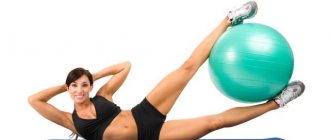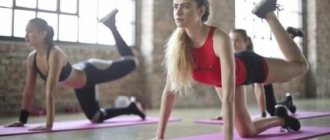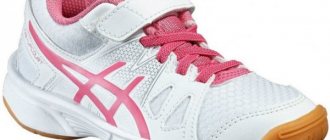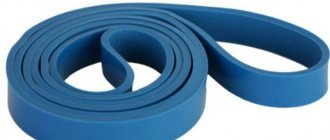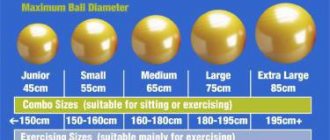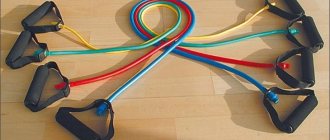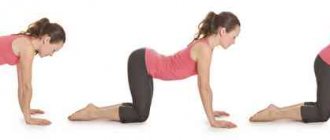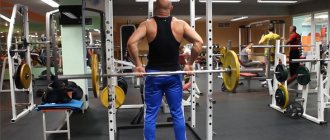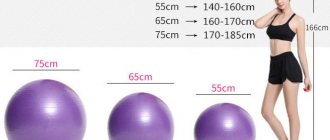A healthy foot anatomically has two arches that support it, help keep the body in balance and act as shock absorbers. With flat feet, they drop, the ligaments are stretched, the bones change their position and become deformed. One of the effective treatment methods in this situation is physical therapy. Carefully selected exercises can give excellent corrective results if performed regularly. Special gymnastics strengthens muscle tone, improves the elasticity of ligaments, reduces pain and increases the patient’s performance.
Goals of exercise therapy for flat feet:
- complete correction of foot deformity (possible only at the initial stage);
- stopping the progression of pathology;
- training the leg muscles to maintain the arch;
- strengthening the skill of correct posture by strengthening the muscular frame of the torso
With flat feet, the spine is involved in the pathological process, so exercises for the legs and feet themselves should be combined with general strengthening exercises that involve the muscles of the back, abdomen, and thighs.
Rules for the use of exercise therapy for flat feet
- Regularity – at least 1 time per day
- Lesson duration – 15-20 minutes
- Combination of gymnastics with self-massage of feet
- Gradual increase in load
- Exercises are performed barefoot
A set of basic therapeutic exercises for flat feet in adults
Exercises are performed from starting positions standing, sitting and lying down. To correct and consolidate the results, alternate walking on your heels, toes, and on the outer and inner edge of the sole. In this case, the metatarsal muscles and plantar aponeurosis are especially strengthened.
An approximate set of exercises for flat feet
- Warm-up
- walking on toes and heels – 1-3 minutes;
- walking on the inner and outer surface of the foot – 1-3 minutes;
- standing on one leg, bend the other at the knee and rotate the ankle in different directions, change legs (15-20 times);
- feet shoulder-width apart, slowly rise on your toes, feeling each toe and slowly lower yourself (15-20 times);
- stork pose – raise one leg, bending the knee, stand for 20-40 seconds (preferably with eyes closed), change leg;
- feet shoulder-width apart - perform half squats, placing your arms to the sides
- Exercises performed from a sitting position on a chair:
- Scatter small objects in front of the chair and try to collect them with your toes (2-3 minutes);
- bend your toes, forcefully fan them out (15-20 times);
- exercise “caterpillar” - bend your fingers and pull your heel towards them, straighten and repeat “steps” 15-20 times;
- roll a rolling pin, a ball, a hedgehog ball with your foot (2-3 minutes);
- grab the ball with your feet and move it in different directions;
- keep your socks on the floor, raise your heels 15-20 times;
- Exercises performed from a sitting position on the floor:
- extend your leg, bend the other at the knee and slide your foot along the floor (10-15 times with each foot);
- stretch your legs and forcefully stretch your toes away from you, then towards you (15-20 times)
- Exercises performed from a supine position:
- bend your legs and spread them apart - clap your heels together;
- bend your leg at the knee, press your hand to your chest, make circular movements with your ankle, change legs (15-20 times)
- Cool down while standing
- walk on your toes and heels, on the outer and inner edge of the foot;
- do the “swallow” exercise, moving one leg back (you can hold on to the back of a chair), the body moves forward;
- rotate your torso to the sides without moving your feet
The set of exercises is indicative. Before performing the exercises, you should consult with your doctor, who will adjust the regimen, supplementing it with special exercises necessary for a particular patient.
Special devices for exercise therapy for flat feet
For greater charging efficiency, various special aids are used that help stimulate several muscle groups and provide the additional effect of self-massage:
- ribbed boards,
- geometric cubes;
- rubber balls with special protrusions,
- beveled surfaces with edges,
- rugs with bumps;
- gymnastic sticks;
- balls of different diameters;
- Teraband;
- and much more.
Exercises with auxiliary objects should be included in all cycles of classes; they can be performed outside the full cycle, as independent exercises (for example, while working at the computer, rolling a pimply ball with your foot). Before class, it is advisable to massage your feet and legs, and after class, have a relaxing foot massage.
Systematicity of therapeutic exercises for flat feet
Good results with exercises can only be achieved if they are performed regularly - 1-2 times a day for 15-20 minutes
Exercise therapy as a prevention of flat feet
Exercise therapy is an excellent prevention of flat feet. Moreover, prevention should be done already in early childhood, when the articular-ligamentous apparatus begins to form. Throughout life, it is useful to walk barefoot on grass, on uneven ground, on sand and pebbles. To consolidate the effect, you should combine exercises with an adequate motor regimen, self-massage of the legs, and wearing the right shoes.
Conclusion
Physical therapy, when performed regularly and conscientiously, is one of the main methods of treatment for flat feet. Properly selected and regularly performed exercises can stop the progression of the disease, and in the initial stages in childhood, even correct emerging foot pathology. But, if the disease is already obvious, then even the most intense physical training will not correct the flat foot, although it can still slow down the progression. The complex should include exercises to strengthen the abdominal and back muscles, and to correct posture. Exercise therapy should be combined with other recommendations of the orthopedist - the correct choice of shoes, wearing personal insoles and orthoses, a course of physiotherapy. All exercises must be coordinated with your doctor, as they are selected individually in each specific case!
Recommendations for conducting classes
To restore the correct shape of the foot, it is important that exercises for transverse and longitudinal flat feet are carried out regularly (2-3 times every week). At each lesson, choose 5-6 exercises (preferably always different ones: then the exercises will be more effective).
Not only gymnastics for various types of flat feet, but also massages and physiotherapy can correct the shape of the foot. In addition, walking in orthopedic shoes or with orthopedic insoles is a very effective means for preventing and correcting deformities. You need to be especially careful when choosing shoes for children. Be sure to ensure that the inner insole is not flat. There should be a convex place on the inside of the foot that follows the correct shape of a person’s legs.
It is very important that gymnastics for different types of flat feet be carried out in children for preventive purposes, since in childhood the foot is most susceptible to deformation. Children can engage in exercise therapy in kindergartens or at home, with the participation of their parents.
Do these exercises - and very soon you will notice that gymnastics to get rid of flat feet gives a positive result. The correct shape of the foot will provide comfort when walking, a feeling of lightness in the legs and improved well-being.
What are the benefits of exercise
The “attachment” of the human foot is a large number of small bones that are connected by ligaments and muscles. The shock absorption of the foot is provided by their connections: longitudinal and transverse. They are “responsible” for a person’s balance while walking. Pathological disorders in one of the arches, due to which the foot becomes flattened, become the cause of flat feet.
It was not possible to determine exactly why the disease appears. However, doctors identify factors that contribute to its occurrence:
- Excess weight;
- Genetic predisposition;
- Using deformed old shoes;
- Lack or insufficient amount of physical activity;
- Wearing uncomfortable or low-quality shoes, prolonged and regular use of high heels.
Incorrect distribution of the arches that make up the leg leads to one of three types of flat feet:
- Transverse. So, they call pathological changes in the transverse arch. The disorders are associated with improper pressure on the metatarsal bones. The size of the foot changes: the length becomes shorter, and the forefoot becomes wider. Its deformation leads to intensive growth of the “bump” on the big toe, the appearance of corns and dry calluses.
- Longitudinal. Often accompanied by additional symptoms: pain in the lower back and joints in the legs. Also provokes headaches.
- Combined. A weakened ligamentous apparatus of the foot becomes the cause of a pathology that develops in two “directions” at once.
Pathological changes of three types will be eliminated by gymnastics for flat feet, massage and the use of orthopedic shoes.
Foot training is needed to correct incorrect arches. It is also important to consolidate the results obtained, so exercises for flat feet should be performed over a long period of time.
The most effective exercises are those that target several muscle groups at once.
The effectiveness of exercises
Physiotherapy exercises are prescribed as part of the general treatment of foot deformity. The selection of exercises depends on the severity of the deformity. Treatment of transverse flatfoot with gymnastic exercises allows achieving the following results:
- strengthening muscles and ligaments in the affected area;
- improve blood circulation, prevent circulatory disorders;
- reducing mechanical pressure exerted on vascular areas and nerve fibers;
- reducing pain when walking, eliminating swelling;
- giving the transverse arch of the foot a physiologically correct position.
A set of effective exercises
Considering the need to engage several muscle groups, gymnastics for flat feet is performed from 3 positions: lying, sitting and standing. For classes, additional equipment is used: balls, cubes and gymnastics sticks.
It is better to select exercises for adult patients with an experienced orthopedist, who, taking into account the specifics of the development of the disease, will choose the desired complex. The same rule is followed when choosing gymnastics for flat feet for children.
Before you begin the main part of your training, it is important to do “warm-up” movements to warm up your muscles.
Basic exercises
A set of training exercises for transverse flatfoot in adults begins with the main part. You can include such movements in it.
- It is necessary to walk slowly around the hall on your toes for 2-3 minutes, and then on your heels for the same time. Each side of the foot is worked in the same way.
- Stretch your arms up and intensively stretch behind them, as if after sleep, standing on tiptoes. You need to remain in this position for 20 seconds. Then sit back on your heels, placing your hands on your waist. Repeat the movement 10 times.
- It is important to do the next exercise in a lying position. Place your hands on the sides of your body, intensively pull your socks on your feet and begin rotating movements with them for 2-3 minutes. These movements strengthen and stretch the leg muscles and ligaments well, and therefore help restore the lost shape of the foot.
- "Applause" with heels. Starting position – lying down. Place your arms along your body, lift your legs, spreading your knees to the side and connecting your heels. Connect and separate the soles for 3-4 minutes. The movements should resemble the flapping of butterfly wings.
- Sit in a comfortable position. Using the foot of your right foot, stroke your left shin for 3-4 minutes. Change the position of your legs.
Chair exercises
The obligatory equipment when performing these exercises is a chair. The movements are shown to be performed while sitting on a chair so that the legs remain bent at the knee joint at all times. The feet must be firmly planted on the floor.
Here are a few exercises for flat feet in adults.
- Tear your socks off the floor for 3-4 minutes;
- Raise your heels for 3-4 minutes;
- Perform 2 movements in parallel: lifting the heel of the right foot and the toe of the left for 3-4 minutes.
- Place your right leg on your left knee. The shin should be vertical to the knee. Rotate your right foot, consistently changing the direction of movement for 3-4 minutes. Change leg positions.
- While sitting on a chair, try to grab small objects scattered on the floor with your toes. Proper execution of the exercise will help build the strength of muscle tissue and restore the tone and shape of the feet.
- For several minutes, consistently bend and straighten your toes.
- Sit cross-legged. With your toes curled, stand on the side arches of your feet.
- Place a gymnastic stick on the floor and carefully roll it over the entire foot for 3-4 minutes.
- Imagine yourself as a street artist. Place a piece of landscape paper under your feet, wrap your toes around a pen or marker and start creating!
The effectiveness of therapeutic exercises
Exercise therapy is designed to strengthen the muscles of the lower extremities and feet, thereby reducing the risk of progression of flat feet. The effectiveness of therapy increases with an integrated approach to solving the problem. To achieve positive results as quickly as possible, in parallel with training, it is recommended to use:
- foot baths – help relax muscles and normalize microcirculation of lymph in tissues;
- foot massage – improves blood circulation and relieves tension after gymnastics;
- orthopedic insoles - support the arch of the foot while walking and reduce the load on the metatarsal bones.
If you regularly perform gymnastic complexes, correction of foot deformities occurs within several years. However, the symptoms of the disease - pain, swelling, fatigue while walking - disappear after two months of regular exercise.
Flat feet is an orthopedic pathology, the treatment of which involves the use of gymnastics and special sets of exercises. To increase the effectiveness of therapy, various combinations of exercise therapy techniques are used. Corrective exercises from a lying, sitting and standing position help to work out all muscle groups of the foot, thereby speeding up the process of correcting deformities.
Useful video - Treatment of flat feet. Doctor Postnov's gymnastics
Exercises from a standing starting position
Sets of exercises from a standing position allow you to work out the muscle tissue of your feet and legs. The starting position for all movements is the same: legs are placed shoulder-width apart, and hands are placed on the waist. Let's list the exercises that are done while standing.
- Consistent walking on your toes for 3-4 minutes, the same on your heels. Then work on all sides of the foot for 4 minutes each.
- Slowly “roll” your foot from toes to heel 30-40 times.
- Rotate the foot of each leg in turn, first in one direction, then in the other direction 20-25 times. This simple movement strengthens the ankle ligaments and foot muscles.
- Stand on your toes 30-40 times.
- Extend your right leg forward, clench and unclench your toes for 3-4 minutes. Repeat the movement with your left leg.
- “Shift” the weight of your body to the outside of your feet, then stand straight. Repeat the movement at least 30 times.
- While standing, pick up small objects scattered on the floor with your toes.
- Do deep and “incomplete” squats up to 30 times.
- Do the Swallow exercise. With its help, the transverse arch is well strengthened. Focus on your right leg, and take your left leg as far back as possible, lifting it off the floor. Maintain balance by leaning towards your right leg. “Hold” in this position for 10 seconds. Change the position of your legs. With each workout, the amount of time you hold your balance should gradually increase.
What is flat feet
Flat feet are usually understood as a change in the arched curvature of the foot, caused by movement or deformation of the tubular bones and the musculo-ligamentous apparatus of the foot. This provokes a change in the appearance of the foot, worsens gait, and disrupts the functioning of the musculoskeletal system as a whole.
The shape of flat feet is determined by which specific curve of the foot - longitudinal or transverse - becomes flat and loses its curved shape. Based on this feature, longitudinal, transverse and transverse-longitudinal flatfoot are distinguished.
Thickening of the transverse bend of the foot provokes a fan-shaped branching of the metatarsal bones. The big toe moves toward the outer edge, the shape of the middle toe changes, and the length of the foot decreases. This form most often develops in young and middle-aged people.
The flattening of the longitudinal arch of the foot, on the contrary, increases its length, since its sole is almost completely adjacent to the floor. This form usually forms in youth (before 25 years). If we are talking about transverse-longitudinal flatfoot, then it is formed when both curves of the foot are aligned.
Flat feet can occur due to the following reasons:
- congenital;
- paralytic;
- rachitic;
- static;
- traumatic.
Only an orthopedist can determine the form, cause and stage of development of flat feet. He makes the diagnosis after taking the following measures:
- Taking anamnesis;
- Foot examination;
- Gait study;
- X-ray examination.
In adulthood, flat feet develop due to the following reasons:
- Genetic predisposition;
- Foot and ankle injuries; Constant extra stress on the foot: heavy lifting, working in a standing position, too active participation in traumatic sports, and so on;
- Physical inactivity, sedentary lifestyle;
- Overweight;
- Constantly wearing uncomfortable shoes, shoes of the wrong size, high heels.
Flat feet is an insidious disease. It not only causes deformation of the foot and toes, but can also provoke other problems, including arthritis and arthrosis, osteochondrosis, hernias, curvature of the spine, clubfoot, and varicose veins. The disease also changes posture and gait, provokes severe pain when moving, and contributes to a deterioration in the overall tone of the body.
It is quite difficult to cure flat feet completely in adulthood, especially if you see a doctor at the wrong time. Therapy will include medications, physiotherapy, massage, the use of special shoes or orthopedic insoles, and special exercises. Exercises for flat feet in adults are an important part of treatment. They will differ depending on the shape of your flat feet.
Types of foot flattening
The following types of deformations are distinguished:
- traumatic;
- congenital;
- rachitic (in children);
- paralytic;
- static.
Therapeutic exercise will help stop further changes in the cartilage and bone structures, and even restore the normal shape of the longitudinal and transverse arch of the legs. The effectiveness of exercises is determined by the regularity of execution and technicality.
- Transverse - as can be seen in the photo, in this case the arched bend of the feet is deformed, and this leads to the divergence of the metatarsal bones like a fan. The thumb deviates to the side. The load on the foot causes the skin to become denser, which is why painful calluses appear on the surface of the foot.
Important! This type of disease accounts for 56% of all foot problems.
Exercises for feet with longitudinal flat feet
, special exercises for flatfoot in adolescents and adults can be effective Among them are the following:
- Sit on a stool with your feet off the floor. In this state, rotate your feet first inward, then outward. Make 20-30 turns in each direction.
- Walk in place without lifting your toes off the floor. Raise only your heels and extend your feet as high as possible. It is recommended to perform the exercise for several minutes without interruption.
- Stand straight with your feet shoulder-width apart. Alternately stand on your toes and heels, making smooth but fairly strong rolls. Carry out the procedure for 3-5 minutes, achieving complete exhaustion.
- Sit on the stools. Connect the heels of your two feet, rotate your feet on the floor, then separate your heels and connect the toes of your two feet so that your knees do not touch. Repeat the movements for five minutes without taking breaks. At first, the exercise may seem difficult and cause pain, but as your foot heals, you won’t have to put much effort into doing it.
- In a standing position, simultaneously lift the heel of one leg and the toes of the other, and stay in this position for as long as possible. Repeat the exercise at least 10-20 times depending on your feelings.
- In a standing position, lift the toes of both legs at the same time and hold them in this position for as long as possible, standing on your heels.
- In a standing position, simultaneously lift the heels of both legs off the floor and stay in this position as long as you can, holding on to your toes.
- Take a sitting position, cross your legs and perform long and slow rotations of your feet alternately.
- While sitting on a chair, raise both legs, stretch them horizontally, pulling them as high as possible. Try to stay in this position for as long as possible.
- In a sitting position, grab a ball weighing at least a kilogram with your soles, lift it to the maximum height and hold it in the air, then smoothly lower it to the floor.
- For at least 15 minutes, walk with your bare feet across a thick stick, pressing well on the instep area.
- The squat “duck step” is also effective. Move slowly, dragging your two feet behind you.
Transverse flatfoot: exercises for treatment
Exercises for transverse flatfoot in adults are presented in large numbers. The complex must be approved by a doctor. The first group of exercises is performed lying on your back. Spread your legs slightly, and after each approach, rest for 5-10 seconds.
- Pull your toes towards you, performing movements with both legs and without moving your body. At the moment of maximum attraction of the feet, turn them inward towards each other so that they touch each other.
- Lift your heels off the floor at the same time, then lower them. First, lift your feet one at a time, then lift them 10 times at the same time.
- Bend your knees, spread your hips, and keep your feet touching. Point the toes of your feet, then press them together. Do the same for the heels. The exercise must be performed quickly, making clapping movements.
- Self-massage exercise. The starting position is similar to the previous exercise, but try to rub the sole of your left shin for 20-30 minutes, then change the position of your legs.
The first three exercises should be performed 7-10 repetitions.
The following exercises for the foot with transverse flatfoot are done while sitting on a chair. The legs should be bent at the knees, and the feet should be slightly apart:
- Alternately lift your heels up 10 times, then lift them 10 times at the same time.
- In a similar position, lift your toes, leaving your heels in place.
- Lifting the heel of your left foot off the floor, simultaneously lift the toe of your right foot, and then return to the starting position and repeat the exercise in reverse.
- Place the shin of your left leg on your right knee and make circular movements with your left foot, first clockwise, then counterclockwise (20-30 seconds each). Then change the position of your legs.
- While sitting on a chair, make caterpillar movements - tucking your toes and pulling up your heels. Take these steps forward and backward without getting up from your chair. You can do this with both legs together or alternately.
Exercises are repeated 10-15 times or for 30 seconds . You can supplement the exercise by grabbing small objects scattered on the floor with your fingers. This will help improve motor skills and provide foot massage. Lift the object with your fingers and move it to another area.
The third complex of physical therapy for flat feet is done standing with feet shoulder-width apart.
- First lift your toes and lower yourself to the floor, then lift your heels 10 times.
- First, lean only on the outer edge of the foot, then only on the inner. Repeat also alternately 10-15 times.
- Depending on your health and age, you can perform squats or half-squats, while placing your arms to the sides. Repeat the exercise 7-10 times.
You can supplement foot exercises for flat feet by walking on your toes, on the outer edges of the foot, with raised heels and bent knees. It is also useful to walk with high knees, lowering or rising in an incline. If you have transverse flatfoot, you should not perform exercises that involve moving your toes to the side, as they can aggravate the condition.
Also, exercises for treating flat feet will be effective when using various objects. You can use a round object like a rolling pin or gymnastics stick. Sit on a chair, spread your feet shoulder-width apart and place an object near your toes, stepping on it. Move your feet forward and back as if rolling an object. In this case, the stick or rolling pin should move along the foot from the toes to the heel and back. This technique should take about 30-40 seconds.
Gymnastics for flat feet in adults is useful, involving the use of a special foot massager. It helps both in the treatment of flat feet and in its prevention. The massager is installed on the floor, you sit on a chair, place your feet on it and perform rolling movements from the toe to the heel. You need to do 10-20 rolls.
Therapeutic exercises for flat feet are an important measure in the treatment of flat feet. When combined with massage and other measures indicated by a specialist, you can achieve clear positive results.
Contraindications to the use of a foot massager
The foot massager should not be used if you have the following health problems:
- varicose veins in severe form;
- any neoplasms (malignant or benign);
- birthmarks on the skin of the legs or skin diseases in this area (ulcers, cracks, fungus, etc.);
- inflammatory processes;
- unhealed injuries, sprains, fractures;
- third stage of osteoporosis;
- kidney and gallstones;
- hypertension (crisis).
Women are also contraindicated from using a foot massager during pregnancy and menstrual periods.
Before purchasing a foot massager, be sure to consult your doctor to make sure there are no contraindications!
Foot massager for varicose veins
Varicose veins, especially in women, are one of the most common diseases of the lower extremities. A foot massager can be a complement to medications. IMPORTANT! The use of a foot massager for varicose veins must be strictly agreed with your doctor!
